Sunflower heads can get very large and dense as they grow and fill with seed. If you plan to use them for seed collection or for decorating, it's important to make sure that they are dried properly. Learn how to dry sunflower heads and get the most out of your beautiful sunflower harvest.

This year we had a small field full of sunflowers which we left to go to seed.
It was fun watching the sunflower heads grow and mature to quadruple their blooming sized faces. They grew in various sizes, shapes and colours, and some grew much larger than others.
Most of those flowers were pollenless sunflowers, so there may not be many seeds at the end of the season. We are keeping our fingers crossed however and are hopeful that we will get at least some seed from the field.
Planning to harvest and dry a fair number of sunflowers takes quite a bit of effort. It was important to decide on a method of drying which would be effective and help to preserve the sunflower heads while they dried.
Last year we tried to dry a whole row of Procut Gold sunflower heads. The flowers were harvested and placed in the rafters of the barn.
When we returned to check on them days later, we found that most of them were completely stripped of seed.
The mice and squirrels had quickly decimated the flower heads, and had collected any seed that existed for food.
This was a valuable lesson learned. It was time for a better strategy.
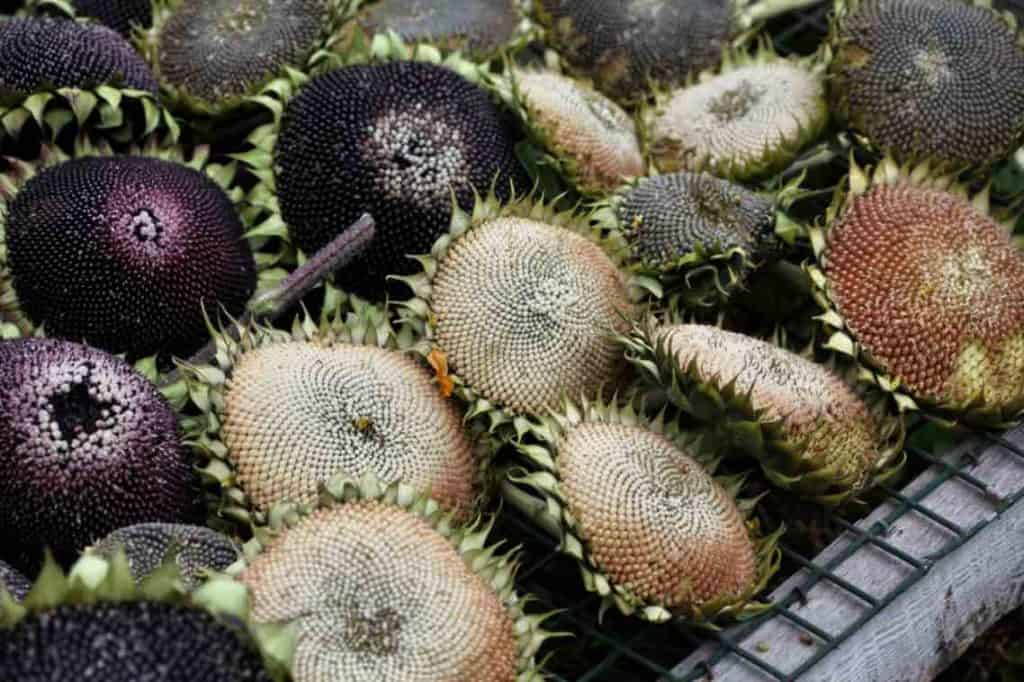
Why Dry Sunflower Heads?
Sunflower heads contain a lot of moisture.
Once they are cut from the stem, they are at risk of moulding if brought inside and if left for any amount of time without the proper drying strategy.
Properly drying them will help to preserve them, especially if you are planning to use them for DIY projects or decorating. If you plan to use the flower heads for decoration, it's very important to dry the heads completely.
Drying will also help with seed collection, allowing the seeds to be more easily removed from the dried heads, because they become looser when dry.
If you only have a few sunflower heads and plan to harvest for seed, you do not necessarily need to dry the heads out first, although it does make it easier.
If you have harvested the sunflower heads from the field in the mature state, the seeds will already be mature and can be removed from the head at any time.
Drying them out further however will just make the process a little easier.

Harvesting Sunflower Heads For Drying
Harvesting the sunflower heads and placing them under cover is an important aspect of drying them.
The flowers will dry better once they are removed from the garden and placed in an area free of moisture.
It's important however not to pick them too early, especially if you plan to dry them for seed.
Allow the sunflower heads to remain on the plant to mature, and then harvest when they are fully mature and ready for picking.

Best Time To Harvest
When the sunflowers have completely finished blooming, the heads continue to mature and ripen.
The outer ray petals in front of the sepals and surrounding the sunflower eventually fall off, revealing a larger sunflower face.
If the tiny florets on the face of the flower have been fertilized, the seeds inside will start to grow and the sunflower head will grow larger and fuller.
Allow the sunflower to remain on the stalk until the flower head is mature. There are telltale signs to look for to determine maturity and the best time to harvest.
The best time to harvest the sunflowers is when the backs of the flowers have yellowed, the heads are nodding, and the florets on the face of the sunflower heads easily rub off with just a brush of the hand, revealing the seeds inside.


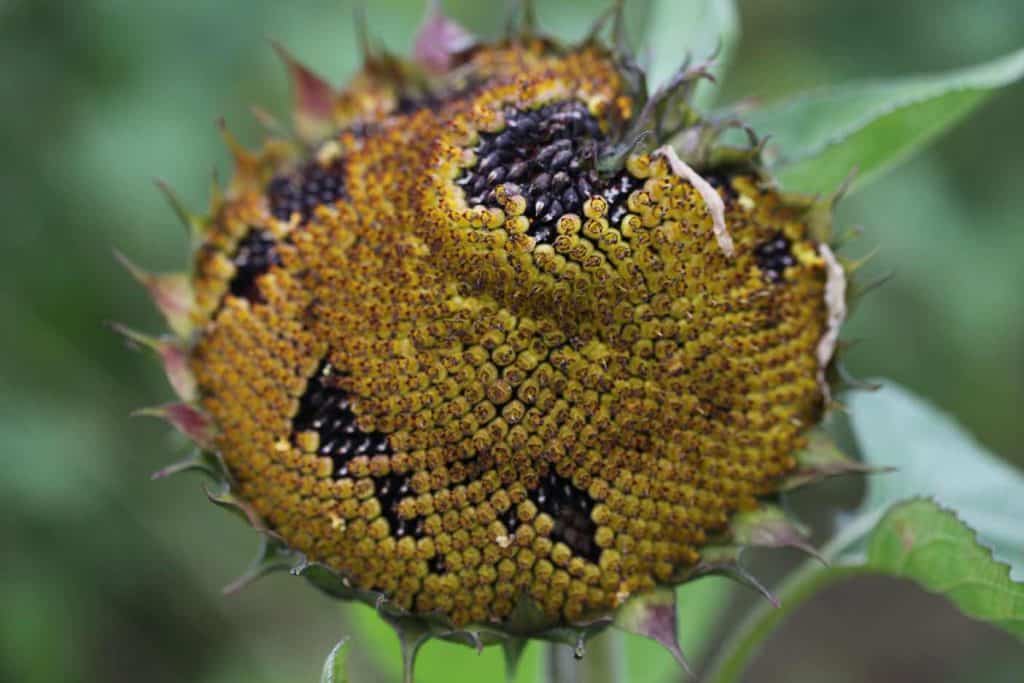
How To Harvest Sunflower Heads For Drying
- Harvest on a dry day if possible. Harvesting in the rain will leave you with wet sunflower heads that are at risk for moulding.
- Cut the flowerhead from the stalk leaving at least six inches of stem attached to the back of the flower, from which you can tie some twine. This is handy if you are planning to hang for drying.
- If you do not intend to hang to dry, you can make the cut flush with the back of the sunflower head.
- Remove the leaves from the attached stem, as well as those on the back of the sunflower head.
- When cutting the leaves from the stem, try to leave few little protrusions on the stem which will allow you to hook a string to securely hang the flower head.
- Remove all the florets on the face of the sunflowers before you bring them inside to dry. It's so much easier to do this outside in the field or garden, as this process can get a bit messy.
- Removing the florets is an important part of the drying process, eliminating extra parts that can retain moisture
- I highly recommend using a pair of gloves to remove the spent florets. Although rubbing the florets off is fun and very easy to do, your palms and fingers will get black and sticky in no time at all.
- I also found that removing the florets while the flowers were still on the stalk of the plant to be a much easier process than removing them after the flowers were cut. The stalk provided a bit of support which was helpful.
- So I generally first remove the florets from the sunflower face, then cut the stem, then trim off the leaves.
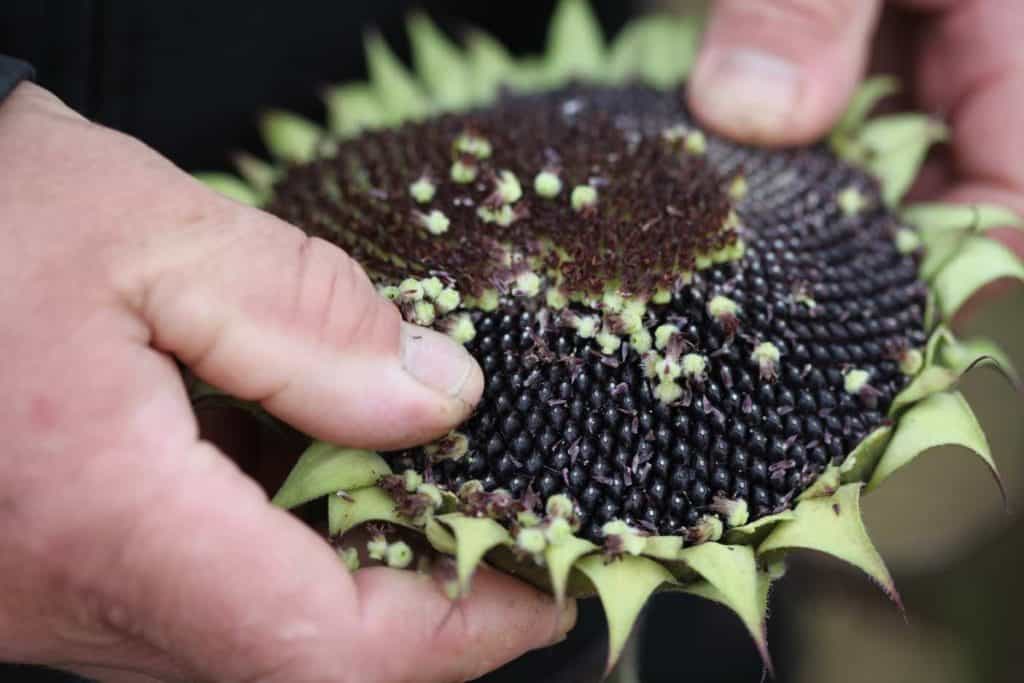

How Do You Dry Sunflower Heads?
Sunflower heads are dense and thick, and are at risk for moulding if left in a moist and cool location. So it's important to find a warm dry location in which to dry your sunflower heads.

It's also important to find a way to protect the seed heads from animals. Ideally they will be placed in a location where animals do not access.
A shed, barn or garage may be ideal.
Hanging To Dry
- Hanging your sunflowers to dry may make the flowers less accessible to the critters, although some mice may still be able to make that journey.
- The process of hanging the sunflowers to dry is ideal, as it allows the flower heads to remain suspended without touching anything. This helps with the air flow and aides in the drying process.
- If you are hanging many sunflower heads at once, make sure that there is a distance between each flower to prevent them from touching.
- Make sure to hang them on a secure line upside down if you decide to hang them in this manner, as many sunflowers hanging on one line will get very heavy. Learn more about setting up a drying line in this post about drying flowers upside down here.

- You can dry several flowers together back to back if you need to save some space. I tend to double up the smaller flowers rather than the larger ones.
- You can also hang the flowers from any sturdy structure. We sometimes use a wire rack in our kitchen to hang flowers to dry.
- Even some hooks behind a door will work.
- One important consideration when hanging sunflower heads to dry is to be aware that some seeds will probably fall out of the flowers as they go through the drying process. Keep an eye on the ground or the floor below to retrieve them, or place a cloth there to catch them.
- Another way to catch the seeds is to cover each individual sunflower head with a paper bag or a piece of cheese cloth. These coverings should allow the flower head to continue to dry while also keeping it safe from any critters or seed drop.



Placing On A Drying Rack
- Drying the sunflower heads on a drying rack is another option if you want to dry them flat instead of hanging.
- If you only have a few heads you can place them on a wire bakers rack.
- We have placed many of our drying sunflower heads on wire shelving units that we usually use for seed starting in winter. The wire shelves allow for good air circulation, which is exactly what is needed for efficient drying.
- It's important that the drying area remain warm and dry to prevent moulding.
- Check on the sunflower heads regularly, and turn them over from time to time.

How Long Does It Take To Dry Sunflower Heads?
Sunflower heads should dry in about two to four weeks. The larger the flower the longer the drying time that will be required.
Drying time is also dependent on the humidity level in the drying area, and the method of drying used.
Sunflowers hung in our warm living area dried much more quickly than those in the barn or those in the basement on wire rack shelving.
Once completely dry, the sunflower head will be stiff and the back will be brownish in colour.
If you are planning to harvest the seed, once the seed head is completely dry, the seeds can be harvested very easily.
Or, if you intend to use them in craft projects, you can start using them once they are completely dry.
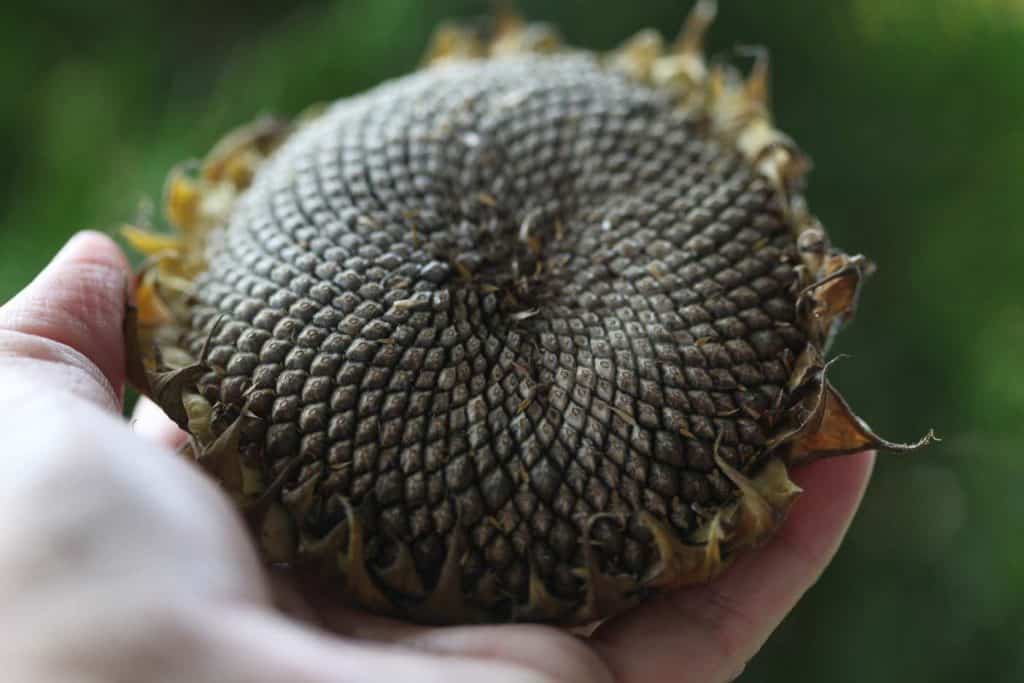
What To Do With Sunflower Heads
Sunflower heads are beautiful specimens of nature.
They are beautiful when they are blooming, and even more spectacular when they are dried.
The symmetrical patterns on the face of the dried sunflower are mesmerizing. Even if you plan to harvest the seed from the sunflower head, it remains such a fun activity just working with the beautiful flower heads.
There are a number of different ways that you can use your dried sunflower heads. Here are a few examples.
Dry Sunflower Heads For Decoration

Dried sunflowers look wonderful in wreaths . They are rustic in appearance and add a country charm to any decor.
Add them to a grapevine wreath or a twig wreath and attach a beautiful rustic bow.
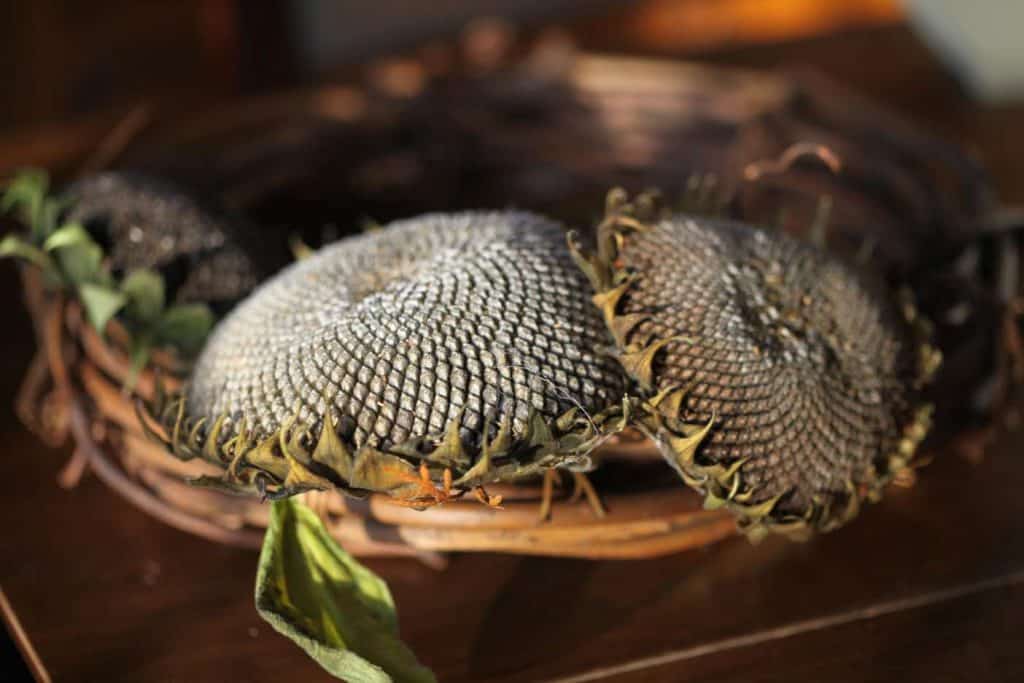
Dry Sunflower Heads For Seed
Drying sunflower heads will help to preserve the seeds and allow for an easier harvest.
When you harvest the seed from the sunflowers, allow to dry on a plate or cookie sheet for several days minimum, allowing them to dry completely before storing.
Store in paper envelopes, which will help to absorb any moisture. Store in a cool dry place.
We use the seeds for next year's plantings, roast a few, save some for the birds, and give some as gifts.
1. Saving Seed For Next Year's Planting
- We buy most of our seeds for planting, because we like to grow pollenless sunflowers for our customers. I love saving seed however, and sunflower seed is no exception.
- Saving seed from pollenless sunflowers is a lot of work for little seed. It's still worth it in my opinion, as every seed has the potential for a beautiful bloom.
- We save some seed for planting sunflowers next year, and you just never know what they will produce.
- The seeds are hybrids, so it's always a surprise.

2. Saving Seed For Eating
- Roasting sunflower seeds in their shells can be a tasty treat for the family, and nutritious way to use your sunflower seeds. The recipe is simple and easy.
- Just follow the directions for roasting the seeds on the National Sunflower Association website here.
3. Saving Seed For Gift Giving
- Packaging up some home grown sunflower seeds will provide wonderful gifts to share with friends and family.
- Put them in small Kraft envelopes and tie them with jute twine for a rustic look.
- Mark on the package the year the seeds were collected, and the type of seed contained in the envelope. The seeds are generally good for a couple of years if stored in a cool dry location.
- If you have a little sunflower stamp, it's great to add to the outside of the package for a nice finishing touch!
- I've given many seed packets of home grown seeds as gifts to gardeners and family, and they are always graciously and excitedly received. I'm probably even more excited to give them!
- I've also given the dried seed heads as gifts, and they are special and unique just as they are.
4. Saving Seed For The Birds

- Drying sunflower heads for the birds can help to feed your feathered friends during the long winter months.
- Store in a cool dry location until ready to use.
Do I Need To Dry Sunflower Heads For Birds?
Birds will find the sunflowers that have been left to mature in the fields. They will feast on the seed right there in the field or garden whenever they can.
However the sunflower heads will compost as they are exposed to the wet outdoor elements, and eventually become mouldy.
It's therefore important to harvest some sunflower heads, so that you can dry them for later use.
Drying them will help to preserve them for a later time, when food for the birds is more scarce.
It's always nice to have a homemade treat of sunflower seeds from your garden to share with the birds through the fall, winter, and early spring.

You can remove the seeds from the seed head and put them directly into a bird feeder.
Alternately you can also just hang them as they are, nicely dried sunflower heads hung outside on a branch or railing, for the birds to find and feast on.
Have you ever tried drying sunflower heads for seed or decorating? Be sure to leave a comment below to share your experience!
Other Posts You May Like:
Other Sunflower Posts You Might Like:
See the Web Story on Drying Sunflower Heads!
PIN IT FOR LATER!








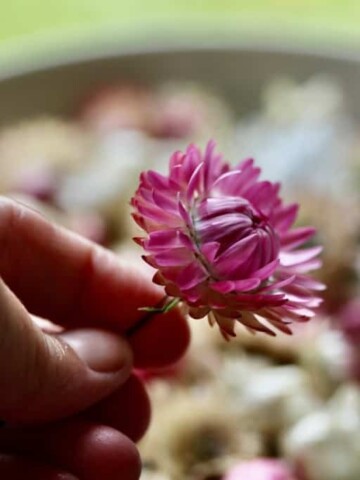

Leave a Reply